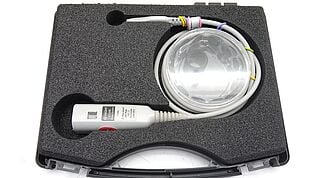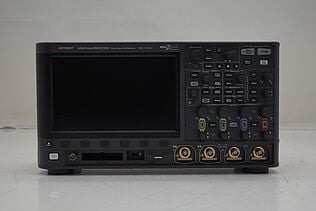- Introduction
- Sample Point Defined
- Why Does it Matter?
- Nyquist-Shannon Sampling Theorem
- Real-world Applications
- Oscilloscopes
- Spectral Analysis
- Communication Systems
- Optimizing Sample Points for Different Signal Types
- Sampling Parameters and Their Impact
- Conclusion
- Whenever You’re Ready, Here Are 5 Ways We Can Help You
Imagine reading a book but skipping nine out of ten pages. You'd miss out on much of the character development, plot twist, and narrative that make the story complete. Similarly, in signal analysis, the sample points are only part of the story. You need the full picture to understand the complete story.
This article will guide you through the critical role that sample points play in understanding and interpreting signals, especially for those who work with oscilloscopes and other signal testing equipment.
Sample Point Defined
A sample point is a discrete value obtained from a continuous or digital signal at a specific instance in time. These points help engineers to reconstruct, analyze, and interpret signals in various applications.
| Key Takeaway |
|---|
| The optimal placement and density of sample points are crucial for accurate signal analysis and depend on the specific type of signal you're dealing with. Tailoring your sampling strategy to the nature of the signal allows for precise reconstruction and minimizes errors. |
Why Does it Matter?
Understanding the importance of sample points is crucial for anyone engaged in signal analysis. Here's why:
- Accuracy: Sample points hold the key to the signal's truth. The density and positioning of these points directly influence how accurately you can analyze and represent a signal. Skimping on sample points can result in a loss of critical information, leading to flawed interpretations.
- Resolution: The number of sample points contributes to the granularity of the digital representation of a signal. More points typically mean higher resolution, enabling more precise measurements and evaluations. This becomes especially crucial when an analog-to-digital converter (ADC) is involved, as the ADC uses these sample points to convert the continuous analog signal into a digital form.
- Reconstructability: Sample points serve as the building blocks for reconstructing the original signal. For instance, in telecommunications, the ability to reconstruct a signal accurately can be the difference between clear, high-quality data transmission and a noisy, unreliable signal.
Proper sampling is not just a theoretical requirement but a practical necessity. It influences everything from the clarity of oscilloscope readings to the reliability of data communication systems. Neglecting to sample adequately can lead to severe consequences, including misdiagnosis of system performance and flawed data analytics. Each sample point is important for signal analysis, as it helps to create a more accurate and detailed picture.
Experience the Precision of Keysight Oscilloscopes
Nyquist-Shannon Sampling Theorem
The Nyquist-Shannon Sampling Theorem serves as the backbone for understanding sample points. The theorem states that you can fully reconstruct a continuous signal if you sample it at a rate that is at least twice the highest frequency component in that signal. In mathematical terms, if \(f_{max}\) is the highest frequency in your signal, the minimum sampling rate fs should be: \(f_s \geq 2 \times f_{max}\)
Key Factors to Consider
- Sampling rate: To accurately reconstruct signals, it is crucial to ensure that your sampling rate meets the Nyquist criterion. A rate below the Nyquist rate can cause aliasing, where higher frequency signals appear as lower frequency signals, resulting in incorrect analysis.
- Sample period: Often overlooked but equally vital is the sample period, defined as the inverse of the sampling rate (\(T_s=1/f_s\)). The sample period is the specific time intervals at which you acquire sample points.
- Importance in digital systems: In digital systems, a clock usually governs this sampling period. A stable and precise clock ensures consistent sampling intervals, resulting in reduced timing jitter and enhanced signal integrity.
- Signal variability: If your signal varies significantly within short periods, a smaller sample period becomes necessary to capture those changes. A larger sample period might miss rapid fluctuations, causing a loss of information.
- Resource management: On the flip side, a shorter sample period means more samples, which requires more computational resources for analysis and more storage space. Engineers often need to balance the need for a high sampling rate (and thus a short sample period) against available resources.
Understanding both the sampling rate and sample period can significantly improve the quality of your signal analysis. Both are intrinsically linked and are vital for accurate, reliable, and efficient signal processing.
Real-world Applications
Oscilloscopes
Oscilloscopes serve as the eyes of an electrical engineer, offering a graphical view of signal behavior. To visualize this behavior, oscilloscopes rely heavily on sample points.
- Digital Storage Oscilloscopes (DSOs): Unlike their analog counterparts, DSOs store these sample points for subsequent, in-depth analysis. The DSO can capture events as short as nanoseconds and allow for repeated playbacks, enabling engineers to scrutinize the behavior of complex systems closely.
Spectral Analysis
Sample points play a pivotal role in spectral analysis, which aims to deconstruct signals into their constituent frequencies. This process is invaluable for identifying the specific components and behaviors within complicated signals. By understanding the significance and arrangement of sample points, you can decode the underlying elements of any signal, enhancing your capacity to diagnose issues or optimize performance.
Communication Systems
In our connected world, the role of sample points extends well beyond the lab. Cellular networks and broadband services, which are essential for data and voice communication, heavily depend on sample points.
- Transmitting analog information: The information to transmit often starts as an analog signal. To send this over a digital communication network, the system takes sample points of the analog signal and converts them into a digital format.
- Quality of service: The density and arrangement of these sample points can significantly influence the service's quality. A high sampling rate can produce clear and high-quality calls or faster data transmission but demands more bandwidth.
- Data compression: Engineers also use sample points for data compression strategies, allowing for more efficient use of network resources. Techniques like pulse-code modulation (PCM) depend on the proper selection and arrangement of sample points to work effectively.
- Error correction: In digital communication, sample points carry signal information and extra data for error detection and correction. This ensures that the received signal can be accurately reconstructed even if some data packets are lost or corrupted during transmission.
From the oscilloscopes that engineers use for diagnostics to the communication networks that keep us connected, sample points ensure that signals can be captured, analyzed, and transmitted reliably and accurately.
Optimizing Sample Points for Different Signal Types
Choosing the right sample points can be highly dependent on the specific type of signal you're analyzing. Here are the key considerations:
- For sinusoidal signals, adhering to the Nyquist-Shannon criterion usually suffices, and phase-locked loops can enhance timing.
- Square waves require sampling based on the highest harmonic of interest due to their complex harmonic structure, necessitating higher sampling rates.
- Triangular waves demand a moderate sampling rate focused on the highest harmonic you're interested in, as per the Nyquist criterion.
By tailoring your sample point strategy to the nature of the signal, you can achieve more accurate and efficient analyses.
Sampling Parameters and Their Impact
| Parameters | Impact on Signal Analysis | Best Practices |
| Sampling Rate | Influences accuracy and reconstructability. | Follow the Nyquist criterion. |
| Sample Period | Affects resolution and signal granularity. | Choose based on signal variability. |
| Bit Depth | Determines quantization levels and noise. | Use higher bit-depth for more precision. |
| Clock Stability | Impacts timing jitter and signal integrity. | Use stable and accurate clock sources. |
| Filter Type | Affects aliasing and noise. | Choose filter based on application requirements. |
| Storage Capacity | Limits the number of samples that can be stored. | Ensure adequate storage for your sampling rate. |
Understanding how these parameters affect the quality of your signal analysis can help you make informed decisions when setting up your equipment for data acquisition or analysis.
Discover Our Selection of Used Oscilloscopes
Select up to 3 instruments to compare
Enable Notifications
In order to use this feature, you need to enable notifications.
Manage notification preferences
Conclusion
Mastering the art of sample points can dramatically enhance the precision and reliability of your signal analyses. The type of signal, be it sinusoidal, square, or triangular, dictates your sampling strategy, making it critical to understand these nuances for effective signal measurement and reconstruction.
Ready to take your signal analysis to the next level? Don't miss out on the exceptional deals at Keysight Used Equipment Store. Discover premium, used oscilloscopes, signal analyzers, waveform generators, and multimeters that deliver professional-grade performance without the premium price tag.

Whenever You’re Ready, Here Are 5 Ways We Can Help You
- Browse our Premium Used Oscilloscopes.
- Call tech support US: +1 800 829-4444.
Press #, then 2. Hours: 7 am – 5 pm MT, Mon– Fri - Talk to our sales support team by clicking the icon (bottom right corner) on every offer page
- Create an account to get price alerts and access to exclusive waitlists.
- Talk to your account manager about your specific needs.








































